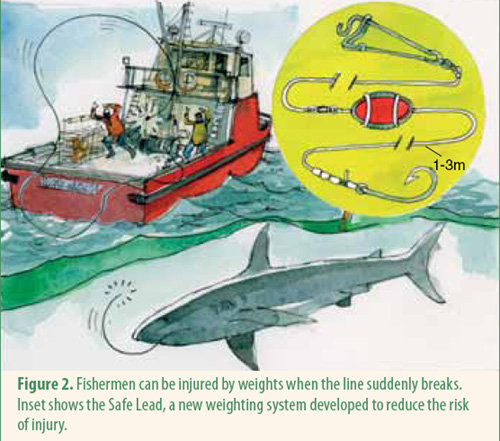Catching fish, not birds: proposed changes to branch-line weighting regimes in pelagic longlining do not reduce target catch rates
Graham Robertson (Australian Antarctic Division, Kingston, Tasmania) and colleagues has published early view on-line in the journal Aquatic Conservation: Marine and Freshwater Ecosystems on improving ways to reduce seabird mortality in the Australian pelagic Eastern Tuna and Bill Fish longline fishery . "The main seabird species affected are fleshy-footed shearwaters (Puffinus carniepes), great-winged petrels (Pterodroma macroptera) and Diomedia spp. and Thalassarche spp. albatrosses."
The paper’s abstract follows:
“Experiments were conducted on two new branch line weighting regimes designed to reduce the risk of seabird mortality in the Australian pelagic longline fishery. The experiments compared the sink rates and fish catch rates of the new regimes with that used by the fishing industry.
Baited hooks on gear with a 120 g lead weight 2 m from the hook reduced the time to reach 2 m, 5 m and 8 m depths by 16%, 58% and 70%, respectively, compared with industry standard gear with 60 g at 3.5 m. Baited hooks with 40 g leads at the hook reduced the time taken to reach 2 m, 5 m and 8 m depth by 33%, 28% and 25%, respectively. The reduction in time with a 60 g lead at the hook to these depths was ~40%.
There were no statistically detectable differences in catch rates of target and non-target fish between industry standard branch lines and branch lines with both 120 g leads at 2 m and those with 40 g leads at the hook. The results contest the widely-accepted opinion that major branch line modifications, including weight at the hook, reduce fish catch.
The regime with a 40 g lead at or very close to (i.e. ≤ 0.5 m) the hook has the most potential for adoption in fisheries due to: (i) improved crew safety; (ii) ease of port-based inspection for compliance purposes; (iii) reduced construction costs; (iv) reduced bin tangles; and (v) ease of deployment. Lead loss from shark bite-offs can be minimized by placing leads on short (≤ 0.5 m) leaders. In areas of moderate to high risk to seabirds, or where the risks are unknown, the use of 60 g leads either at or ≤ 0.5 m from the hook is encouraged.”


Safe leads as used in the Australian experiments. Photograph by Graham Robertson
Reference:
Robertson, G., Candy, S.G. & Hall, S. 2013. New branch line weighting regimes to reduce the risk of seabird mortality in pelagic longline fisheries without affecting fish catch. Aquatic Conservation: Marine and Freshwater Ecosystems. DOI: 10.1002/aqc.2346.
John Cooper, ACAP Information Officer, 24 April 2013

 English
English  Français
Français  Español
Español